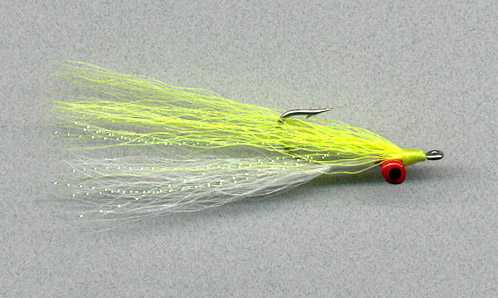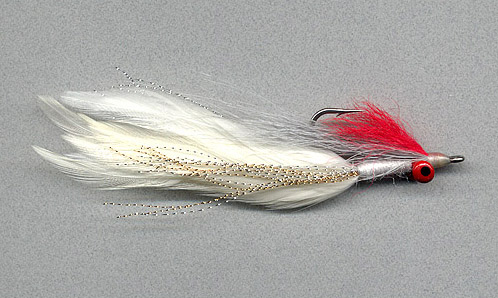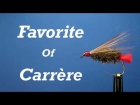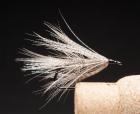Merrimack River
During my self-introduction to flyrodding the salt, I went elsewhere. When I did, I looked to one place. The Merrimack River was that place. For me, that river has produced more decent fish and more exceptional fishing memories than most places on the east coast.
 An average size Merrimack schoolie |
 Stripping baskets are essential to long casts on the jetty. |
 A fish on top taking my silicone slider. |
 Sandeels are the primary food source during the early months. |
 A decent striper that fell for Roger's Big Eyed Baitfish. |
 Roger's Big Eyed Baitfish. A big bite for big fish. Click on the image for a larger picture and the pattern recipe. |
 Chartreuse over white Clouser Minnow, a universal classic. |
 The Conomo, a highly mobile and durable baitfish imitation. |
 Half Clouser Minnow, half Lefty's Deceiver, the Half and Half can't help but be a winner. |
 The Jiggie is a bucktail baitfish fly with a large and heavy head for plenty of action in the water. |
 Nobody should go striper fishing in the Merrimack without a good sandeel imitation. |
 Dan Blanton's big fish fly - the SarMulMac - is another large profile baitfish |
For many anglers, exploring new water can be frustrating, intimidating, challenging, and downright exasperating. The simple reason for this is that fishing new water is quite similar to meeting new people. First impressions are lasting ones. Some conditions that I have found are things such as water so muddy that it looked as if I was floating on chocolate milk; water so crowded that a passing boat removed my 400 grain Teeny effortlessly from my reel; fog so thick that a look down to zipper my jacket threw me into a new, unexplored planet. The list goes on. These are things that a flyrodder must endure, and many of them accept. Things get complicated however, when these things happen on the first trip to a promising location. Once you have become fairly familiar with a location, the trick then is to avoid the crowds and find fish. Even trickier, at times, is to stand tall and produce fish amongst the hoards of chunkers and bait draggers. This can be frustrating, however, like most factors, can be overcome with some hard detective work and an open mind.
I live in New Hampshire, which has a whopping eighteen miles of coastline. For most in this small state where "Live Free or Die" is stamped into our license plates, and our egos, eighteen miles is not enough to explore or to catch decent fish. Some don't bother, some do, and some go elsewhere. During my self-introduction to flyrodding the salt, I went elsewhere. When I did, I looked to one place. The Merrimack River was that place. For me, that river has produced more decent fish and more exceptional fishing memories than most places on the east coast. It is my hope that a thorough look into the river, it's bottom, structure, and it's currents will lead you to better fishing, and bigger fish. I am planning to divulge my hot flies. Admittedly, this is with some apprehension. However, in the world of fly-fishing it is almost a duty to pass along good, solid information. It is how we teach, learn, and progress in order to the take the sport passion and love that much further.
The Mouth
In early to mid-May, the Striped Bass (Morone Saxatilis) arrives in the mouth of the river. This depends greatly on water temperature within the river itself, as well as the bait needed to keep the fish there once they arrive. Without the bait, the fish will move in, and at times be very difficult to locate. Fairly consistently, once the water reaches temperatures of approximately 60 to 62 degrees Fahrenheit, these fish will begin to move into the river itself and begin gorging themselves on sandeels. The mouth of the Merrimack River has been known to be extremely treacherous due to incredible tides and the standing waves that they produce. Couple this with a proper moon cycle and an opposing wind, and the wave conditions can be such that even the larger long distance boats will not exit the mouth.
As the river flows eastward into the Atlantic, the volume of water that is moved rapidly through the mouth seems to increase every hour. Couple this with standard river flow, as well as an outgoing tide, and you may find yourself wondering how your drift went so quickly. If you're on shore, you will no doubt spend time wondering how you can make an effective retrieve, when all that happens is your line touches the water then suddenly becomes part of the jetty your are standing on. Specifically at the mouth itself, the river narrows considerably, thus increasing the water speed. Speed plus volume essentially equals less than favorable water conditions. Out of all these factors, I still have not mentioned one - wind. With an outgoing tidal flow, outgoing river flow, and a westward wind, wave height increases, quickly, and at times, violently. The mouth is no place for a novice boater, and at times, is really no place for an experienced boater. I strongly suggest you become familiar with your existing and predicted weather conditions, as well as the moon phase and tide schedule.
Structure
Striped Bass like current, structure, depth changes, and bait. If you can fish one out of the four mentioned, chances are you will produce. Now add to one of those what I consider to be refuge water, and your chances at hooking a decent if not enormous fish has just doubled. Large fish like to have the opportunity to be right in the action. Adversely, they like to have the chance to relax, refuel and conserve energy. Large stripers are opportunists.
To be able to reserve strength and energy without constantly having to fight current is key for these larger fish. In a constantly changing environ such as the Merrimack River, these large fish have the perfect opportunity to find an area to refuel themselves by using little energy. The key to this is structure. The fish
can refuel their energy supply by resting, and then return to the current and bait that flows with it, to feed on sandeels, mackerel, and worms that are flowing out with the tide.
Structure blocks the current and tidal flow by interrupting it. Structure may be considered to be a jetty, a drop-off, a large rock, a group of pilings, or simply put, a moored boat. In the mouth, structure is abundant. Jetties are positioned at the mouth of the Merrimack on both the north side of the river as well as the south side.
This enables fish to use these jetties on both tidal swings, thereby increasing the "fishability" of the mouth. On an outgoing tide, I have found that as the water flows past the south jetty's point, and immediately is swept in a southeastern direction, nearly at a forty-five degree angle. Before it heads in this direction however, the water and wash generated from the rocks and waves sits nearly at a standstill, creating somewhat of an eddy. This eddy will remain in the same vicinity throughout the tidal flow, and will move as the flow increases and eventually subsides. During this time, that eddy, or resting place for larger fish, is accessible by either boat, or by caster from the jetty itself. I have found that a suspended baitfish imitation, such as a Sar-Mul-Mac, a Conomo Special, or a Roger's Big Eyed Baitfish will bring these fish up from their respective resting places. Initially, fish these presentations slowly on an intermediate line. This will allow them to be presented two to three feet into the water column and strike zone. Fish them slowly as if crippled, simply because wounded baitfish do not move fast. They tend to find themselves absorbed in the natural selection process, eventually ending up as prey. It has been my experience that presenting a faster retrieve to a resting fish will at times initiate a strike. However, while presenting a slow retrieve to that same fish, opportunity knocks, if you will, and success is just around the corner. From the point of the jetty southeastward, you will experience exceptional drifts in the event you have access to a boat. As you proceed east exiting the river, the bottom contour affords many the opportunity to fish deep. Here the fish will be large and strong. Initially as the water exits the river, the bottom rises up by several feet, on a low tide, offering depths of thirteen to sixteen feet. These several feet afford the fish enough of a current change to produce a resting place for their feeding binges.
Having more than one line type inside your gear bag is the best bet. I infrequently use a floating line. I do however, like to fish deep. Larger stripers not only like to rest, they like to feed in low light conditions. Obviously, early morning and late afternoon hours produce a substantial amount of fish. Does this mean you should not fish for them during the bright sunny days of spring and summer? Simply put, this means to present your offering to them deeper, where there is less light.
Remember, too, that by fishing deeper, you are also accessing a type of structure - drop-offs. I prefer to fish by covering varying layers of the water column. I like to present my flies with an intermediate line initially, and when current, depth, light condition, and bait dictate, I change over to a faster even-sinking line. The reason for the even sink is that while fishing a current (I fish from a boat), I can present my fly at the depth I want.
While it is there, so is my fly line. This decreases the amount of slack I have my line, while increasing the feel, and my chances of hooking a decent fish, and hooking it well.
From the north jetty, on the New Hampshire side of the river, excellent opportunities abound. While the river maintains somewhat of a southeastern flow, there is a pocket of water on the south side of the north jetty that, based on appearance alone, tells of a bottom contour change. Here the water smoothes, while maintaining its constant flow. Water depth ranges from fifteen to twenty two feet, and then returns back to fifteen, approximately. This takes place for the last forty-five to sixty feet of the jetty on the riverside. A fast sinking line with a weighted fly such as a Clouser, Half and Half, or a Jiggy works well. Count down your depth according to your sink rate, and fish on the down current side of your boat as you drift. This will increase your line's ability to get where you want it to go. If you present your fly up-current of your boat, you will notice that your drift depth is significantly less than the aforementioned method. This results in your line being pulled through the water as opposed to "pushed" with the current.
Adding a weighted fly to the equation ensures you're fishing at your target depth. I like to retrieve half of my running line, and in an effort to increase time in the strike zone; I simply allow my retrieved line to feed itself back out, and back into the strike zone. Short strips and a slower retrieve allow the fly to remain at the desired depth for a longer period of time.
Either jetty at the mouth of the river provides for excellent opportunities to catch decent fish. Make sure to watch for bird action. The terns on the river live there, and you do not. They know where the bait rafts up on various current conditions, and where there is bait, there are stripers that feed on it. Pay particular attention to smaller groups of birds as opposed to enormous flocks. Often times a keen-eyed angler that spots two or three terns working the surface will be on to fish sooner than the anglers who think that a group of two to three birds don't constitute an investigation. Also remember that when the bait is on the surface, chances are good the fish are below pushing the bait upward. Just because you see birds but no crashing fish, doesn't mean the fish aren't there.
Always remember to be safe when fishing on or near currents such as the one described here. Make sure you bring or have easily accessible, a personal floatation device, a whistle, flashlight or headlamp, or both, if you're on foot. If you happen to fish this river by boat for the first time, do it during daylight so that hazards can been seen and avoided. After ten years of fishing this piece of water, I am still hesitant to exit the mouth without some light. Lastly, remember to have patience, and fish deep and slow. That way your chances at a behemoth are that much better. You'll be that much closer to the action, and when you're right there, mathematical odds tell you your theory will produce.

Roger's Big Eyed Baitfish
| Hook: | Mustad 34007 or equivalent, size 2 - 6/0 |
| Thread: | Danville's Flat Waxed Flymaster Plus, Size A |
| Tail: | Six to eight saddle hackles topped with pearl Krystal Flash |
| Throat: | White bucktail tied in succession toward hook eye, with red rams wool at the throat |
| Shoulder: | Grey bucktail tied in succession toward hook eye |
| Eyes: | Primsatic cheek and eyes |
| Topping: | Herring back Krystal Flash topped with peacock herl |

Clouser Minnow
| Hook: | Mustad 34007 or equivalent, size 6 - 2/0 |
| Thread: | Danville's Waxed Flymaster Plus, Size A |
| Tail: | White bucktail with chartreuse Krystal Flash rolled into it. Tie the excess forward to the rear of the dumbbell eyes. |
| Eyes: | Your preference of lead, tungsten, steel, etc., dumbbell eyes |
| Wing: | Chartreuse bucktail |

Conomo Special
| Hook: | Mustad 34007 or equivalent, size 1 - 3/0 |
| Thread: | Fine clear monofilament |
| Tail: | Sea Hair or Big Fly Fiber in following order (bottom to top) pearl, gray, blue, black. |
| Head: | Corsair tubing |
| Eyes: | Witchcraft stick-on eyes |

Half and Half
| Hook: | Mustad 34007 or equivalent, size 2 - 3/0 |
| Thread: | Danville's Waxed Flymaster Plus Size A |
| Tail: | Six saddle hackles topped with silver and copper Krystal Flash |
| Body: | For sizes 3/0 or greater, I use these with sparkle yarn bodies. 2/0 and smaller the body is bound thread as described in the clouser minnow. |
| Wing: | GreyBucktail |
| Shoulder: | Red Calftail |

Jiggie
| Hook: | Mustad 34007 or equivalent, size 2 |
| Thread: | Fine monofilament |
| Throat: | White bucktail topped with silver holographic Krystal Flash |
| Shoulder: | Olive Bucktail |
| Head: | Jiggy head coated with epoxy after eyes added |
| Eyes: | Witchcraft epoxy eye |

Bubb's Sandeel
| Hook: | TMC 811S, Mustad 34007 or equivalent, size 6 - 1/0 |
| Belly: | Pearl flashabout |
| Shoulder: | Smoke Ultra Hair |
| Body: | Belly and shoulder materials pulled back and coated with epoxy |

Sar-Mul-Mac
| Hook: | TMC 811S, Mustad 34007 or equivalent, size 6 - 1/0 |
| Thread: | Danville's Waxed Flymaster Plus Size A |
| Tail: | Six white saddle hackles |
| Shoulder: | Blue bucktail toped with blue holographic Flashabou top with peacockherl |
| Throat: | White bucktail and red ram's wool |
| Head: | One wrap of red chenille, remainder white chenille. After head wrapping is complete, pull excess peacock herl over head assembly |
| Eyes: | Witchcraft epoxy eye |
Read more about why you should register.
More content from the front page
Since you got this far …
… I have a small favor to ask.
Long story short
Support the Global FlyFisher through several different channels, including PayPal.
Long story longer
The Global FlyFisher has been online since the mid-90's and has been free to access for everybody since day one – and will stay free for as long as I run it.
But that doesn't mean that it's free to run.
It costs money to drive a large site like this.
See more details about what you can do to help in this blog post.


























































Comments
Your detailed inform
Your detailed information is very helpful to me as a seasoned ocean striper fisherman brand new to the Merrimack River and respecting it's strong tides! I'll certainly fish the eddies and be extra careful of the strong currents with my children on board. It's also been tough finding articles involving the low tide depths of the river. Thanks again!
Sand Eel Flies
Merrimack River Flies is a local fly shop that carries flat wing sand eels that work great. There are always sand eels in the Merrimack and everyone should have some imitations in their fly box. www.mmrf.us.com